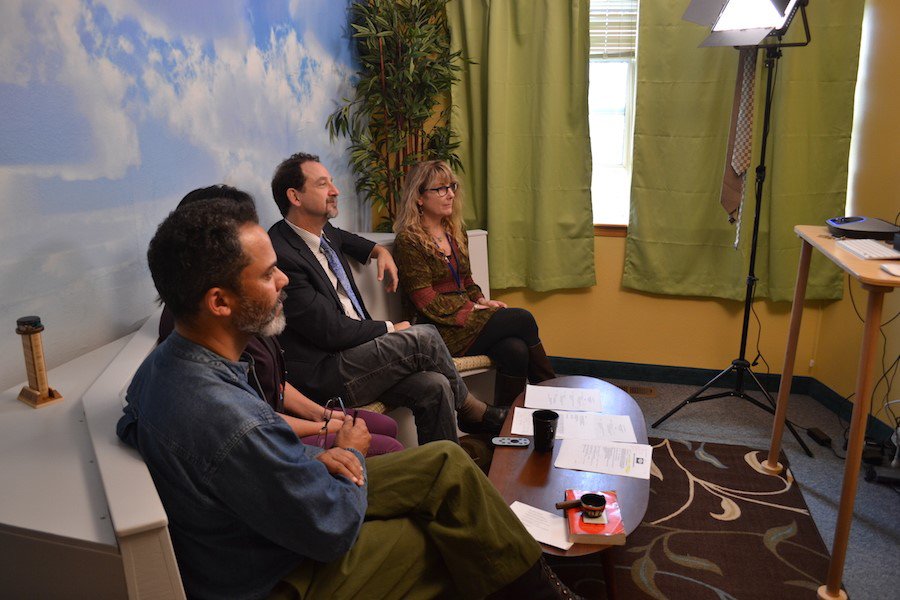Telemedicine 3.0: How Video Technology Can Support People With Serious Illness

Telemedicine has come a long way in the last fifty years.
From science fiction beginnings, as NASA’s virtual health monitoring for astronauts, today’s telemedicine can deliver compassionate person-centered care with just a click on a hand-held device. The accelerating pace of technology that is pressing us back in our seats – ubiquitous smartphones, lightning fast connections, and cloud-based processing – now support the deep and personal work of caring for our fellow human beings in their most vulnerable moments. Video calls can open a magic window into the lives of people under our care, allowing us to establish and maintain relationships without intrusion, and helping us to reach more people in need. This evolution, what I call Telemedicine 3.0, opens a world of opportunity that will transform the care of people living with serious illness.
"Video calls can open a magic window into the lives of people under our care, allowing us to establish and maintain relationships without intrusion, and helping us to reach more people in need."
Telemedicine 3.0 depends on payer-provider partnerships
Under traditional fee-for-service medicine, however, clinicians are not reimbursed for telemedicine visits to people’s homes, making it a hard sell for already stretched palliative care program budgets. For programs operating under this payment model, telemedicine is at best an add-on service to manage out-of-hours issues or for in-home nurses to use to consult with colleagues about something they see during a face-to-face visit. While this undoubtedly contributes to care quality and program efficiency, so much more is possible.
For instance, at ResolutionCare Network, we contract with payers under monthly fee arrangements that are agnostic to communication channels. We have found that video-enabled medicine is supporting more than 40 percent of our visits while our team exceeds all our quality metrics. These video visits are typically made by MD, NP, or PA team members and visits can include all core palliative care services such as pain and symptom assessments, treatment decisions, goals of care, and advance care planning conversations.
ResolutionCare Network is held to a series of quality metrics, as defined by the program’s contracts with different payers.
As our fellow palliative care program leaders explore new payment models under value-based care, we recommend looking for payer-provider partnerships that will prioritize the quality of patient care, rather than the specific method used to deliver it. Program leaders can use that flexibility to deploy Telemedicine 3.0, or indeed, the next innovation to support quality care.
Telemedicine 3.0 provides easier access to care for the people who need it most
While telemedicine may never fully replace the clinic visit or house call, consider the benefits of a telemedicine visit for a person living with a serious illness like metastatic cancer, advanced heart disease, or kidney failure.
This person – let’s call her Ethel – may have had scores of visits in the last twelve months to some site of care for lab work, appointments with specialists, X-rays, treatments, emergency department care, maybe a hospitalization or two. When a palliative care team can make virtual visits with Ethel, she doesn’t have to spend two hours overcoming pain, symptoms, and functional challenges to get ready for another doctor visit. She doesn’t have to ask her daughter or neighbor to take time off work again to drive her to an appointment; she doesn’t have to get in a car, spend any time on the road or looking for parking. She doesn’t have to cope with the waiting room, or encounter other sick people, front desk staff, or the ever-present clipboard of questions. Nor does Ethel have to worry about whether her home is presentable, or any of the other social norms associated with receiving a visitor at home.
All Ethel has to do is click on a secure link on a device that she already has, or that a family member or one of our community health workers has set up for her. (We have around forty devices that we loan to folks, if needed, and we can also pay for their data plans.) Most of our patients are comfortable using this very simple technology, and others pick it up very quickly with the help of our community health workers.
ResolutionCare Network’s Quality Metrics
ResolutionCare Network’s Medicaid Managed Care partners (Partnership HealthPlan of California and California Health & Wellness) require:
- Bi-monthly submissions to the Palliative Care Quality Network (PCQN), a learning collaborative with the goal of improving the quality of palliative care services. The PCQN collects a standardized set of data for each patient seen.
- Documentation of two visits (either a video visit or house call) by an RN, SW, MD, NP, or PA.
- Quality bonuses are awarded for:
- POLST completion rates
- ER avoidance
ResolutionCare Network’s commercial insurance partners (Blue Shield of California and Healthnet) require:
- Joint Commission certification (currently in process)
- Inclusion of the health plan’s program associate in Interdisciplinary Team meetings
Telemedicine 3.0 gives people control
And then a really powerful thing happens: when Ethel lets us into her home via video link, she controls exactly what we see and don’t see. Her consent is needed for every revelation: what is in the fridge, or in the medicine cabinet? This may seem like a loss for providers when compared with a home visit – and in some ways it is – but the control that Ethel gains may have more value.
At ResolutionCare Network, many of the 200 people and families under our care live in vulnerable conditions, with histories of homelessness, substance use disorder, or physical abuse. For them, a home visit from a medical professional or social worker is intimidating.
Video calls redress the imbalance of power by putting the people under our care back in control. The screen preserves a boundary, making the interaction feel less risky, and still allowing for personal connection. We can ask Ethel to show us the contents of her medicine cabinet, and she can decide whether she is comfortable doing that. Our team still makes home visits to assess the environment, but they are most often made by one of our cadre of community health workers – compassionate team members who can approach our patients as peers. Our model allows us to set the right balance of video or in-person visits based on patient needs – which is as it should be.
"Video calls redress the imbalance of power by putting the people under our care back in control."
Telemedicine 3.0 can help programs become more efficient
Telemedicine has been a cornerstone of the ResolutionCare Network delivery model in no small part because the people under our care live in rural Northern California, where medical care can be three or more hours away from peoples’ homes. By dramatically reducing our windshield time, video home visits have allowed us to take more people into our care, and expand our reach. But Telemedicine 3.0 has also delivered other efficiencies that we did not predict, which can add value for programs in urban and suburban areas too. First, video home visits are generally shorter while covering the same ground. For example, a visit with initial assessment and discussion of goals and advance care planning may take between 90-120 minutes in the home, but only between 60-70 minutes over video. And second, unlike home or clinic visits, video encounters are rarely, if ever, delayed by unexpected traffic, weather conditions or administrative needs.
Our experience at ResolutionCare Network suggests that our use of Telemedicine 3.0 will increase because it is efficient, gives people living with serious illness greater agency, and allows clinicians to meet unmet demand in underserved communities. It is only possible because our payment landscape has changed to give us the flexibility needed to deliver it.
As palliative care program leaders continue to develop models of care delivery under value-based payment, we encourage working closely with payers who will support and champion building interdisciplinary teams and services in a way that can flexibly meet the needs of people under their care, with the most appropriate tools.
"We encourage working closely with payers who will support and champion building interdisciplinary teams and services in a way that can flexibly meet the needs of people under their care, with the most appropriate tools."
As told to Saskia Siderow, Ormond House LLC
